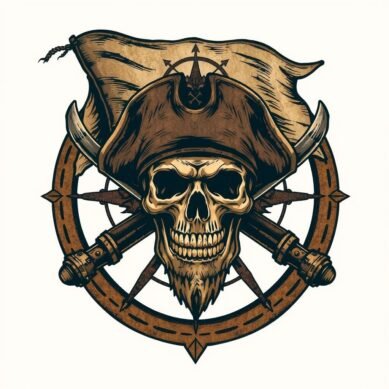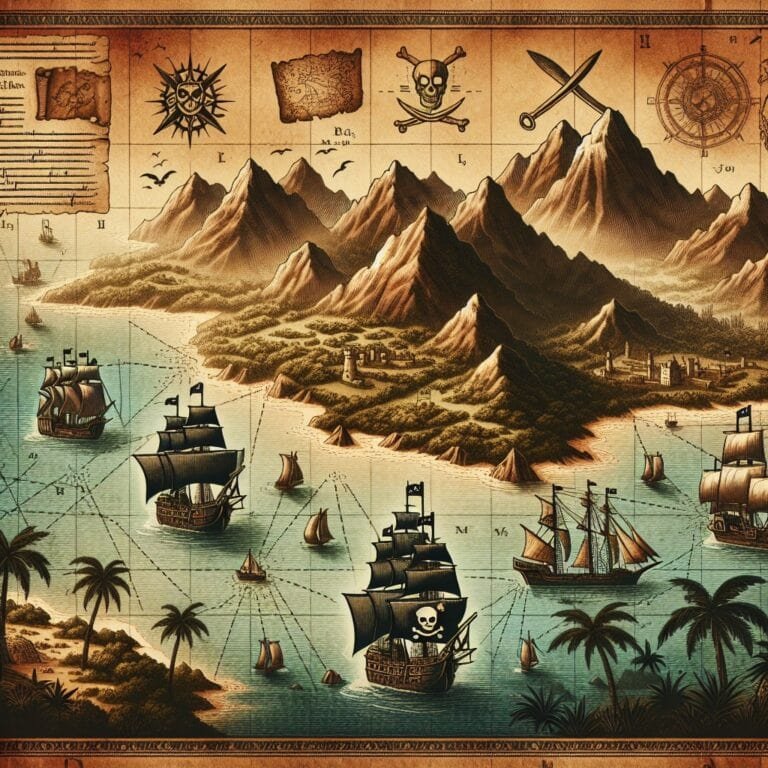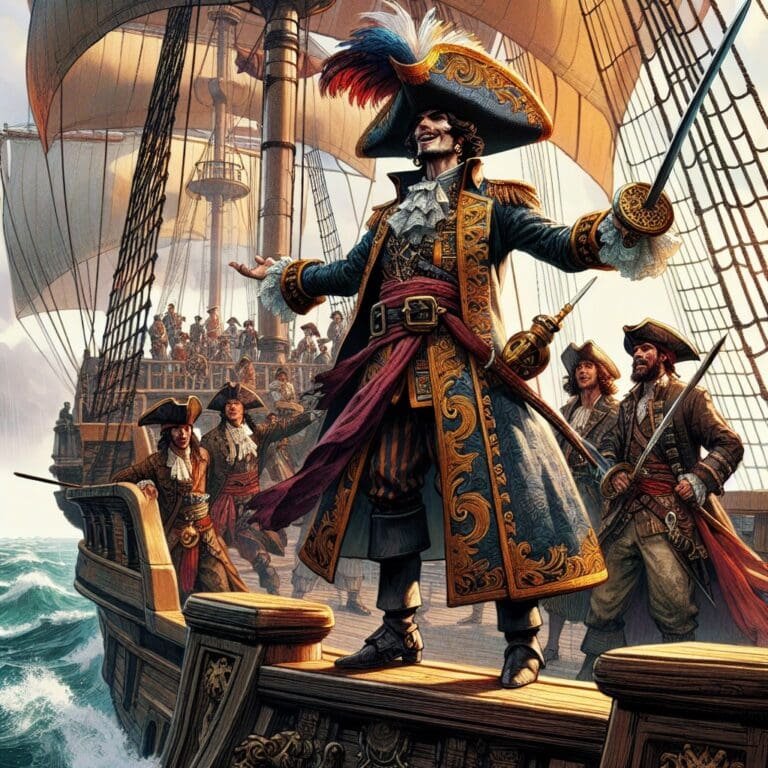# Pirate Flags: The History and Symbolism of the Jolly Roger
## Introduction
The Jolly Roger, the quintessential pirate flag, is an enduring symbol of maritime lawlessness and rebellion. Between the 1650s and the 1730s, known as the Golden Age of Piracy, these flags struck fear into the hearts of sailors and merchants across the seas. This article delves into the history and symbolism of the Jolly Roger, exploring key events, figures, and socio-economic factors that shaped this era. We will also examine the daily life of pirates, their governance, and notable pirate havens.
## Origins of the Jolly Roger
### Early Pirate Flags
Before the iconic skull and crossbones, pirate flags varied widely. Early pirate flags were often simple red or black banners. The red flag, known as the “Red Jack,” signified no quarter would be given, meaning no mercy would be shown to those who resisted1. The black flag, on the other hand, was used to intimidate and coerce surrender without a fight.
### Evolution to the Skull and Crossbones
The transition to the skull and crossbones symbol, known as the Jolly Roger, began in the early 18th century. This design was intended to be both menacing and easily recognizable. The most famous version of the Jolly Roger featured a white skull above two crossed bones on a black background. This flag was popularized by notorious pirates such as Blackbeard (Edward Teach) and “Black Sam” Bellamy2.
## Symbolism of the Jolly Roger
### Nautical Symbols
Pirate flags often included various symbols to convey specific messages:
– Skull and Crossbones: Death and danger.
– Hourglass: The limited time victims had to surrender.
– Weapons (swords, spears): Readiness for battle.
– Hearts: Sometimes pierced by arrows, symbolizing a willingness to kill.
These symbols were designed to instill fear and prompt immediate surrender, minimizing the need for combat and preserving pirate resources.
### Pirate Customs and Governance
Pirates operated under their own codes of conduct, known as “Articles of Agreement.” These articles outlined the distribution of loot, compensation for injuries, and other rules governing life aboard the ship. Notable pirate leaders like Bartholomew Roberts and Henry Morgan enforced these codes strictly to maintain order and discipline3.
## Key Events and Figures
### The Golden Age of Piracy
The period from the 1650s to the 1730s saw a surge in piracy, driven by several factors:
– Economic Disparities: Many pirates were former sailors who turned to piracy due to poor wages and harsh conditions in the merchant and naval services.
– Colonial Expansion: European powers were expanding their colonies, creating lucrative trade routes that pirates targeted.
– Weak Naval Presence: Many colonial powers had limited naval resources to protect their vast territories and trade routes.
### Notorious Pirates
Several pirates became infamous during this era:
– Blackbeard (Edward Teach): Known for his fearsome appearance and ruthless tactics.
– ”Black Sam” Bellamy: Dubbed the “Prince of Pirates,” he was known for his egalitarian leadership.
– Anne Bonny and Mary Read: Two of the few female pirates who gained notoriety for their daring exploits.
## Maritime Challenges and Impact on Global Trade
### Threats to Trade
Piracy posed significant challenges to global trade and colonial expansion. Pirates targeted merchant ships carrying valuable goods such as gold, silver, spices, and textiles. The constant threat of pirate attacks led to increased shipping costs and disrupted trade routes4.
### Legal Repercussions
Governments responded to piracy with harsh legal measures. Pirate trials were often swift and brutal, with many pirates being hanged or imprisoned. The British Admiralty established Vice-Admiralty courts in the colonies to expedite the prosecution of pirates5.
## Daily Life of Pirates
### Pirate Havens
Pirates established bases in remote locations where they could rest, resupply, and repair their ships. Notable pirate havens included:
– Nassau, Bahamas: A notorious pirate stronghold where pirates could operate with relative impunity.
– Tortuga, Haiti: A haven for buccaneers and privateers.
– Port Royal, Jamaica: Known as the “wickedest city on earth,” it was a hub for pirate activity until it was destroyed by an earthquake in 1692.
### Governance and Social Structure
Pirate ships operated as floating democracies. Captains were elected by the crew and could be deposed by a majority vote. Decisions were often made collectively, and loot was distributed according to agreed-upon shares. This egalitarian structure was in stark contrast to the rigid hierarchies of naval and merchant ships6.
## Conclusion
The Jolly Roger remains one of the most iconic symbols of piracy, representing a unique period of maritime history characterized by lawlessness, adventure, and rebellion. The Golden Age of Piracy left an indelible mark on global trade and colonial expansion, challenging the economic and political structures of the time. Understanding the history and symbolism of pirate flags provides valuable insights into the socio-economic factors that drove men and women to a life of piracy, as well as the enduring legacy of these maritime outlaws.
In summary, the Jolly Roger was more than just a flag; it was a powerful tool of psychological warfare, a symbol of pirate identity, and a testament to the complex socio-economic landscape of the 17th and 18th centuries. The stories of notorious pirates, their customs, and their impact on global trade continue to captivate our imagination, reminding us of a time when the high seas were ruled by those who dared to defy the established order.









